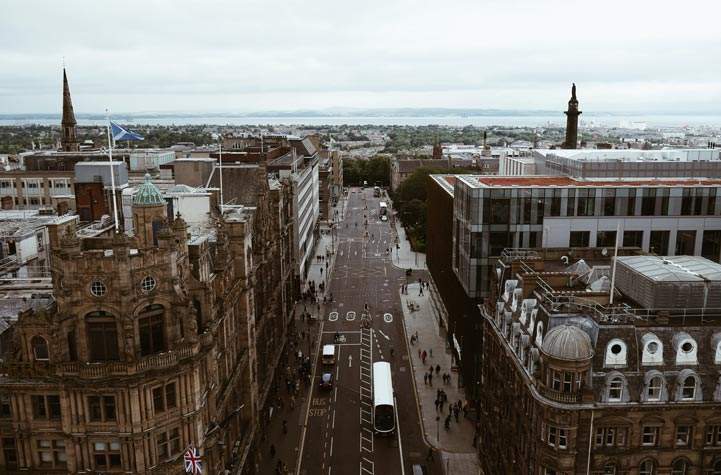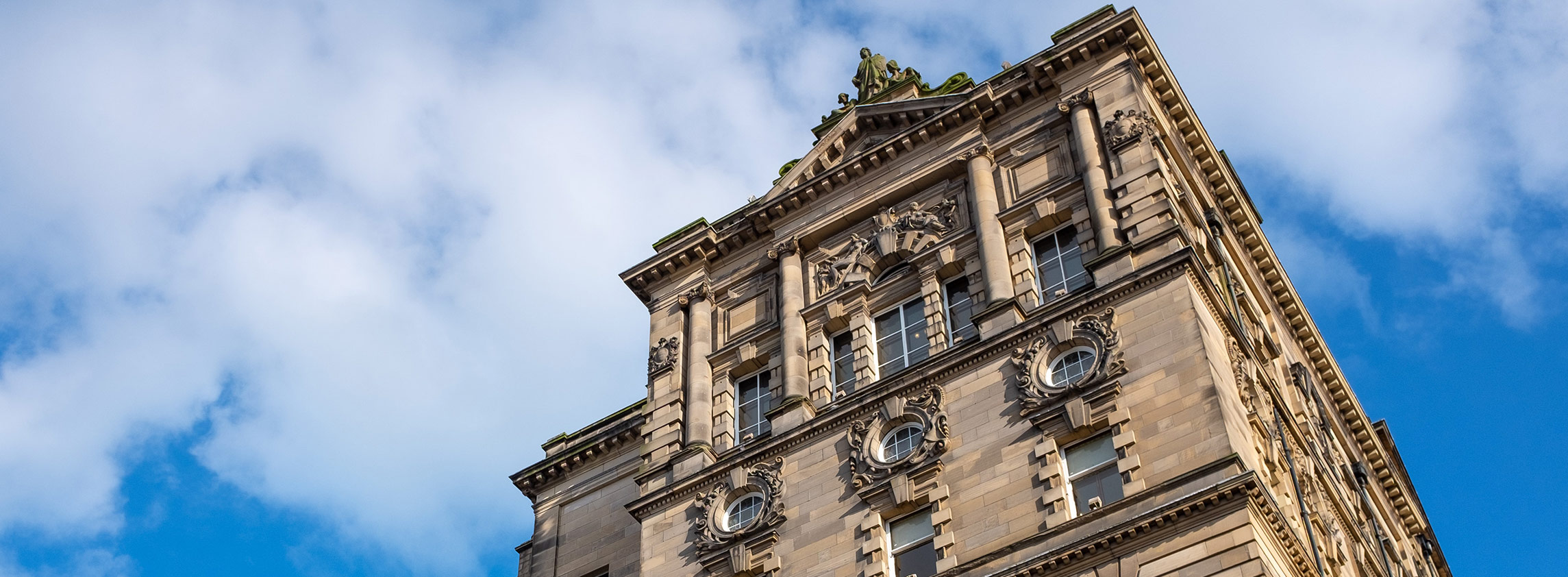The technology sector continues to be a key contributor of office take-up in Edinburgh city centre
During Q1, Edinburgh city centre take-up reached 79,276 sq ft. while this is 12% above the same period last year, it is significantly below the 10-year quarterly average – as take-up remains subdued by the effects of the Covid-19 pandemic.
The Technology, Media & Telecoms (TMT) sector contributed the largest proportion of take-up, accounting for 45%, totalling 35,481 sq ft. Key deals in this sector included Motorola, who leased 10,884 sq ft at Caledonian Exchange along with Rockstar North Ltd and Trustpilot, who leased 9,725 sq ft and 9,283 sq ft, respectively. There was also significant activity from the Public Services, Education & Health sector, which accounted for 16% of take-up, totalling 13,061 sq ft.
The far more relevant market picture is represented by current requirements and occupier activity. Most occupiers are starting to acknowledge that they will not truly know how offices will be utilised until staff start to return in meaningful numbers. Many are, however, of the view that offices will be utilised differently, with themes such as sustainability, wellness and collaboration coming far more to the fore. This is leading to a number of organisations reviewing operational property strategies and looking to potentially capitalise on lease events and expiries by considering relocations. This is leading to significant levels of activity, which, if converted to deals, will lead to a significant uptick in take-up.
Although take-up was limited throughout the first quarter, Savills has witnessed an increased amount of activity in the market in terms of viewings and occupier enquiries
Many of the occupiers that we see in the Edinburgh market at the current time are focusing on new (less than five years old) Grade A offices in the city centre. Such stock is deemed more likely to satisfy ESG and Wellness criteria and provide more ‘future-proofed’ accommodation. The issue in Edinburgh is that stock of this nature is in extremely limited supply with approximately only 220,000 sq ft of current ‘Prime’ availability and much of this is under offer. Unlike other regional centres, the development pipeline in Edinburgh is extremely restricted moving forward, meaning that rents on such accommodation are likely to remain robust with potential for growth.
Currently, Grade A rents in Edinburgh are in excess of £35.50 per sq ft and incentives remain low. Edinburgh has seen consistent prime rent rental growth throughout the pandemic, and we expect this to continue throughout the year.
How Scotland is dramming up international investment
As we all know, international investment into UK commercial property dropped substantially last year, as non-domestic buyers were hit both home and abroad by travel restrictions, severely limiting their ability to inspect and move forward with purchases. That being said, it’s certainly not the case that all international investment activity ground to a halt.

2020 volumes were £1.2bn, down by 46% on 2019. However, the proportion that international buyers were responsible for jumped from 73.2% in 2019 to 78.3% in 2020. Looking at the individual city markets, unsurprisingly Edinburgh was the main driver behind this change: overseas commercial investment rose by almost 10% in 2020 as non-domestic buyers went from being responsible for 63.9% of volumes to 73.2%. In comparison, overseas investors were responsible for approximately 48% of office investment volumes in Birmingham and 43% in Manchester in the same period.
Drilling down specifically into Edinburgh’s office market, overseas buyers were responsible for 96.1% of all office volumes, up from 73.4% in the previous year. South Korea’s Hyundai Asset Management buying Aegon’s UK head office in Edinburgh from M&G for just over £133m in partnership with Roebuck Asset Management is partly responsible for this leap. Germany’s KanAm Grund Group followed its 2019 purchase of Aberdeen Standard Investments’ Edinburgh headquarters for £130m with two Edinburgh buys in 2020. It paid approximately £31m for Knight Property Group’s Edinburgh House at 4 North St Andrew Street and is rumoured to be under offer at M&G’s 3 Quartermile for £45m. US, Middle Eastern, French, Scandinavian and South African buyers have also been active and bidding on assets. Edinburgh prime office yields currently sit at 4.75%, while in Glasgow they are 5.25% and in Aberdeen 6.75%.
So why are overseas buyers going the extra mile to invest in the Scottish markets when things have admittedly been more than a little challenging?
There are a number of macro factors that make the UK overall a top destination for international capital. It’s been said before, but it’s worth reiterating, given that we can be too inward-looking from time to time – placing more emphasis on domestic events than they perhaps deserve from an international perspective – but the UK remains a beacon of stability. Yes, questions remain on the fall-out from Brexit, but the potential consequences are largely seen as being relatively minor compared to upheaval in some jurisdictions around the world.
While some domestic investors may have been deterred, the prospect of a second Scottish independence referendum is a minor concern to international investors relative to the risks they may be weighing up in other markets
Nick Penny, Director, Head of Scotland
While some domestic investors may have been deterred, the prospect of a second Scottish independence referendum is a minor concern to international investors relative to the risks they may be weighing up in other markets. Likewise, the strong fundamentals of the UK’s long lease lengths and its stable legal system through which they can be enforced cannot be underestimated, whatever temporary eviction bans may have been put in force over the past year.
UK commercial property also offers some of the highest cash-on-cash returns across all asset classes, with a combination of the falling all-in cost of finance and comparatively higher yields on offer drawing international buyers to our borders.
But what is pushing Scottish assets above those in the other big regional cities? The cache of Edinburgh as a capital city shouldn’t be undervalued. It punches well above its weight in terms of global recognition and, therefore, international investors are more comfortable acting in it than markets they’re less familiar with, particularly when they’re deploying capital almost “sight unseen”.
The occupational story over the past year has been a selling point too. Edinburgh was the only key UK office market that showed an annual uplift in take-up over 2020, driven by two deals in excess of 100,000 sq ft completing, including Baillie Gifford’s agreement to take 280,000 sq ft at new development The Haymarket. In Glasgow, the Scottish government leased 91,000 sq ft at 220 High Street, while in March, the UK government announced plans to set up a secondary HQ in Glasgow as part of its plan to relocate thousands of civil service roles outside of central London.
Looking ahead, Edinburgh and Glasgow, with their compact city centres and good cultural and leisure mixes, look poised to recover from the pandemic faster than some larger centres as they continue to be attractive to both workers and occupiers alike. With the occupancy story looking resilient, the fundamentals of Scottish property remaining strong, and international buyers having significant pent-up capital ready to deploy, we expect many more deals this year as investors walk (or more likely fly) the 500 miles to Scotland.
